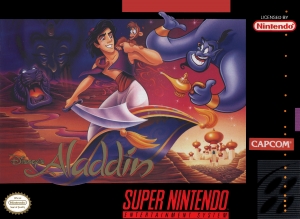
Author: John Legendoffzelda
Capcom’s Aladdin is a triumph. This game, along with Mega Man X and U.N. Squadron are part of a group of Super Nintendo titles I like to call “Capcom’s Undisputable Trio”. Outliers such as Demon’s Crest and Street Fighter II Turbo have their own place in the Super Nintendo canon, but the Trio is made of games that to me show the communal and unique way Capcom was an absolutely first-class game developer.
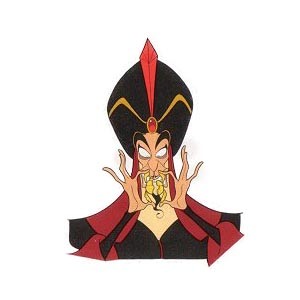 Aladdin is the conclusion, and pretty much the culmination, of the first halcyon era of licensed Disney games. Early in Michael Eisner’s run at the Walt Disney Company, the rights to adapt Disney properties for Nintendo consoles was secured by Capcom. From between 1989 and 1993, Disney properties were put in the hands of game development masters; people who saw vast potential in the franchises given to them and continuously realized it. Capcom is why games like DuckTales and The Magical Quest Starring Mickey Mouse are celebrated video game experiences, and that same line of reasoning applies here.
Aladdin is the conclusion, and pretty much the culmination, of the first halcyon era of licensed Disney games. Early in Michael Eisner’s run at the Walt Disney Company, the rights to adapt Disney properties for Nintendo consoles was secured by Capcom. From between 1989 and 1993, Disney properties were put in the hands of game development masters; people who saw vast potential in the franchises given to them and continuously realized it. Capcom is why games like DuckTales and The Magical Quest Starring Mickey Mouse are celebrated video game experiences, and that same line of reasoning applies here.
Capcom’s Disney deal expired with their adaptation of Walt Disney Pictures’ Aladdin, which was coincidentally released around the same time the film debuted on home video. The game has been in strong contention with Sega’s own video game adaptation, made in collaboration with Virgin Interactive and released around the same time. Virgin Aladdin and Capcom Aladdin have been roundly debated, and support for the former owes to, among other things, an unprecedented collaboration between Virgin and real in-house Disney animators. There’s no right or wrong answer as to which game is superior of course, but Aladdin Capcom stands out because of its own captivating aesthetics and the Herculean strength of its gameplay.
The game’s mechanics and rules, in pure Capcom style, are taught to the player in the first level, in the bright sandy streets of Agrabah. The barrel in front of Aladdin at the start is there for him to jump over, because this is a platformer. The horizontal pole a few frames later is there to swing from, as a vertical pole later on is there to jump on and a ledge later on is there to hang from; these three things dictate Aladdin’s Prince of Persia-style nuances, stylization designed to re-organize the flow of all the platforming. Fancy, yes, but the whole game relies on a mastery of their precision. There’s a segment in the fourth level involving the Genie – he conjures up a series of clouds, playing cards and floating rings that act as tests of the player’s skill; if the player has not yet mastered the Prince of Persia stuff, they have to do it now or else they just can’t advance.
Precise jumps aren’t needed to reach a higher or out of reach surface; Aladdin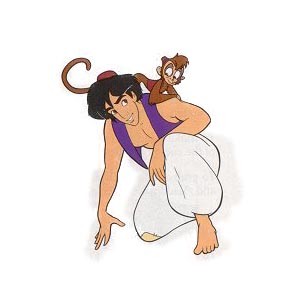 can just grab the edge and hoist himself up. Aladdin doesn’t stomp on enemies and certain ground objects – he leaps off of them, with the same gymnastic grace applied to swinging from horizontal poles, stalactites, and ropes (To simplify the bopping, apples can be collected to lob at enemies, getting rid of smaller ones like bats in the Cave of Wonders and stunning larger ones like palace guards).
can just grab the edge and hoist himself up. Aladdin doesn’t stomp on enemies and certain ground objects – he leaps off of them, with the same gymnastic grace applied to swinging from horizontal poles, stalactites, and ropes (To simplify the bopping, apples can be collected to lob at enemies, getting rid of smaller ones like bats in the Cave of Wonders and stunning larger ones like palace guards).
Each level has three additional mechanics, which create a surprising juxtaposition. There’s a sheet tucked away somewhere that allows Aladdin to slow his descent when falling. There’s a treasure chest containing the golden scarab from the film; catching it and completing the part of the level it was found in activates a bonus stage. The player then spins a wheel around the Genie’s finger and stops it. Depending on which section of the wheel the Genie points at, Aladdin gets either an extra life, an extra hit point or an extra continue. Lastly there’s an assortment of green and red gems; green gems are easy to collect, and gathering 100 of them gives the player an extra life. But red gems are more out of the way and collecting all 70 of them is part of a hidden challenge.
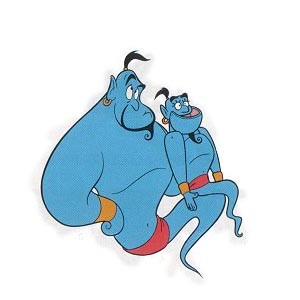 The way this juxtaposition works is that these things have a difficulty decreasing-reward and a difficulty-increasing risk. Floating past parts of a level with the sheet can result in being hit by an enemy over a bottomless pit, or missing a crucial swinging or leaping segment – to say nothing of what happens when Aladdin loses all his lives, restarts the level, and must find the sheet all over again. Going after the red gems or the scarab can result in more haphazard jumping and ledge grabbing if the player is not especially careful. These things round the game out fully, and make it an engrossing platforming experience.
The way this juxtaposition works is that these things have a difficulty decreasing-reward and a difficulty-increasing risk. Floating past parts of a level with the sheet can result in being hit by an enemy over a bottomless pit, or missing a crucial swinging or leaping segment – to say nothing of what happens when Aladdin loses all his lives, restarts the level, and must find the sheet all over again. Going after the red gems or the scarab can result in more haphazard jumping and ledge grabbing if the player is not especially careful. These things round the game out fully, and make it an engrossing platforming experience.
Aladdin glistens with technical excellence, and even with such creative liberties as the pyramid level ( Can you name any reason why that level couldn’t have been about Aladdin at the ends of the Earth?), it’s a terrific representation of the movie. The Super Nintendo’s color display capabilities benefit the film’s color scheme well. Even without bona-fide Disney animators making everything cartoony, the character animations hold up nicely on their own. On that note, some of the feedback in the game contributes a surprising amount of personality; there’s the Scott Weinger-like “Whoa!” Aladdin makes when he loses a hit point, and on certain occasions Abu and the Genie make expressions of shock and loss when Aladdin loses a life. They really care about him. The music just shimmers, and is full of orchestration that effectively evokes jaunty adventure, tense excitement, or mellow wonder. Some of this is due to Alan Menken’s original music, interpreted and re-interpreted in this game well. Most enjoyable of all is the music to the song “A Friend Like Me” in the fourth level, which pulls off the neat trick of demonstrating the recursive nature of Menken’s body of work.
Where Mega Man X defines how Capcom updated an original property and U.N. Squadron defines how they put their personal spin on a genre, Aladdin defines how they appropriated a license. With their Disney games, Capcom created symbiotic relationships; assortments of well chosen mechanics that could exist without the licensed property, while at the same time upholding the property’s nature and feeling so much more appropriate for it. Aladdin makes a lot of sense as a Persia-like game, and Capcom made sure to make it as tight, logical, and satisfying as they could. It will always be part of Capcom’s Undisputable Trio.
Five out of five stars.
![]()
![]()
![]()
![]()
![]()
CLICK HERE TO DISCUSS IN FORUM
HAVE AN OPINION?
You can submit reviews for games on the Submissions page.







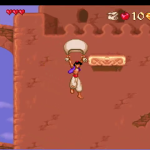
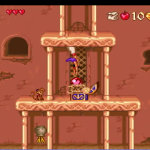
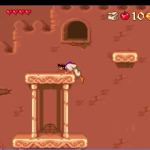

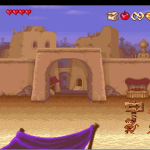

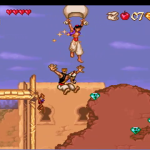
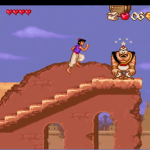

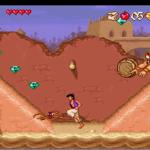
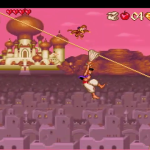
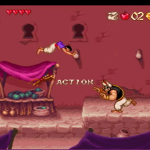
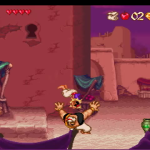


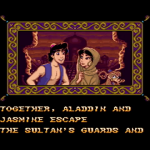
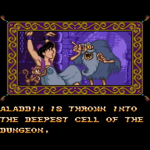
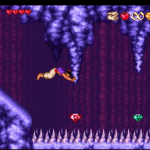
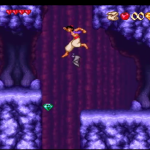

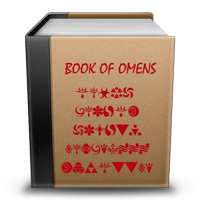
Interesting take on the game. The general consensus has always been that it’s good, though slightly inferior to the Genesis version (though you’ll find no shortage of folks who prefer this version).
I remember this game playing very smoothly, but not looking quite as good as the Genesis version. Ultimately, I found the game to be solid, but it didn’t blow me away. This was of course about 20 years ago.
Based on your review, I may have to give this game a second look one of these days. It’s certainly easy to find and reasonably priced.
You’re right, the consensus does give the edge to the Genesis version. I’ll be honest: I’ve also played the Genesis version, and I still prefer this one. My problem with the Genesis one is that it reminds me of “Earthworm Jim”: it feels better as a cartoon more than a videogame. The animation is awesome, much better than the Super Nintendo characters (which do look static and kind of Filmation-like), but the platforming feels floaty and the combat is kind of awkward.
But that’s just what I think. I won’t tell you the Super Nintendo version is better, and I tried not to do so in my review. Ultimately, I like Genesis “Aladdin” more as a cartoon and Super Nintendo “Aladdin” more as a videogame.
EDIT: I meant for this to be a response to RushDawg above me.
My father bought me the Genesis Aladdin brand new for $49.99 shortly after its release. I beat the game within 12 hours of opening it. I felt kinda bad that I asked for it.
I hope the SNES version can last me longer than that.
Great review. I believe I only played Aladdin on Sega, and it seemed difficult at the time, but I love it. Based on what you shared about Capcom’s rights to adapt Disney movies in the early 90s, I wonder had Capcom had madeThe Lion King, would it too have been “a triumph.” I did enjoy that game, although I only played the Sega version as well.
I’m looking forward to reviewing Capcom’s MVP Football. It doesn’t get talked about much, but I think it makes for a pretty decent sports game.
Both are great platformers but I gotta give the nudge to the Genesis version. With the silky smooth animation and brighter primary colors I always find it a joy to play. I find the controls are slightly more responsive as well but you can’t go wrong with either version. The Genesis Aladdin still looks great in motion even today. I consider it one of the Genesis system’s best if not THE best platformer available.
I played through this game recently and thoroughly enjoyed it. If I had a complaint, it was the difficulty wasn’t high enough.
Then don’t play the Genesis version. I beat it in less than 24 hours!